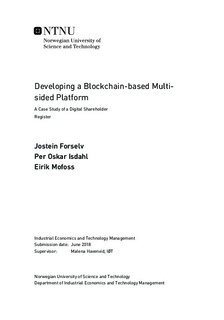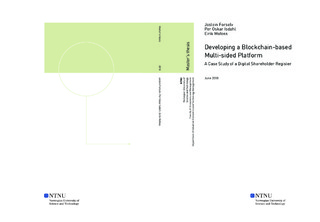| dc.description.abstract | In the last few decades, the world has seen companies such as Amazon and Airbnb arise and grow record-fast, without even offering any new unique product or technology. These are examples of multi-sided platforms (MSPs), enabling direct interaction between different groups of customers. \\
A new technology with unexploited potential is the blockchain technology. Blockchain technology can allow decentralized systems to connect millions of users with each other in new ways, facilitating and recording transactions between two or multiple parties efficiently and in a verifiable and permanent way. More and more companies are combining blockchain technology with the platform model. This thesis researches how value can be created for stakeholders on multi-sided platforms that utilize blockchain technology.\\
We do this by creating a framework to analyze and design blockchain-based MSPs. The main goal of the framework is to maximize stakeholder value creation. We create this framework by combining existing frameworks on MSPs with stakeholder theory. The result is a framework that learns the requirements of a platform through a three-step stakeholder analysis. We demonstrate the framework by applying it on a case study of a proposed platform business, Startblock, a digital shareholder register, where we use both interviews and surveys to collect data from stakeholders.\\
The results show that the value creation from blockchain-based MSPs come mainly from those core services which utilizes the advantages of blockchain technology, such as digital signatures and transparency. These properties allow blockchain-based MSPs to offer:
- Secure trading of assets without intermediaries
- Cost-reduction by improving business processes
- The facilitation of compliance with regulatory requirements
From the application of the framework, we demonstrate how blockchain technology influences both the governance structure and the revenue model of MSPs. Next, we show that the way actors interact with each other heavily influences the blockchain architecture. Our research further shows the importance of stakeholder analysis in understanding the network effects on multi-sided platforms. \\
Finally, to overcome the well-known chicken-and-egg problem for platforms, we argue that new MSPs should start out by providing some core service to a single customer side with low switching costs. This way they can quickly attain a critical mass of at least one desired platform customer group, before they begin to introduce their more typical services with network effects. | en |

